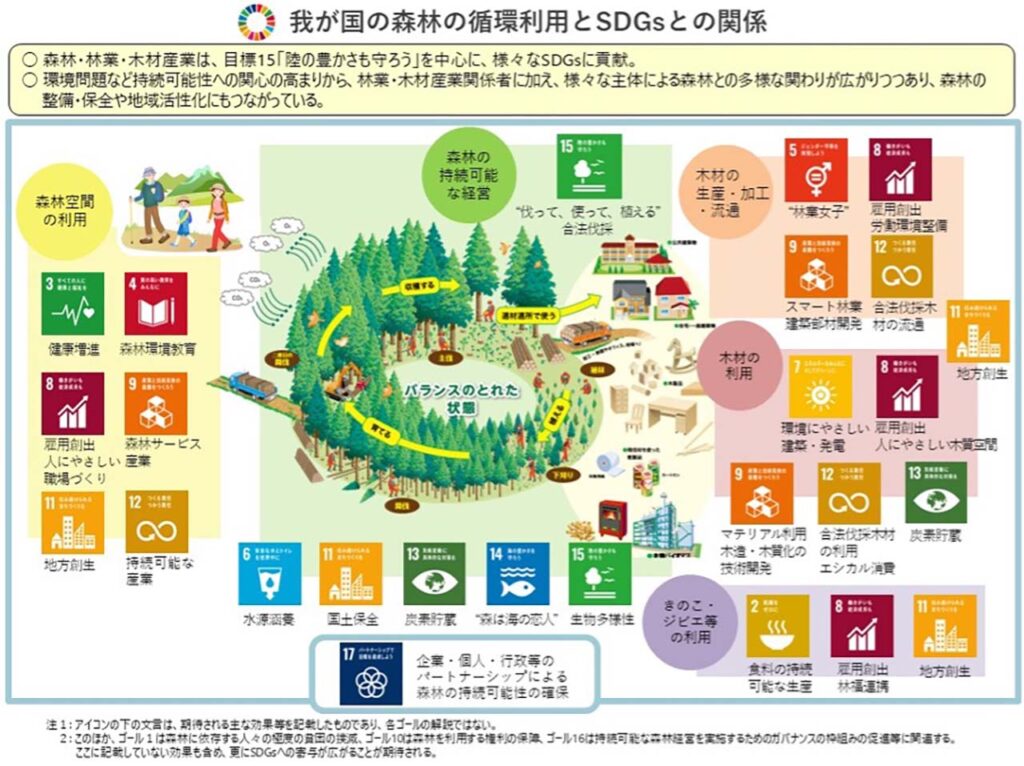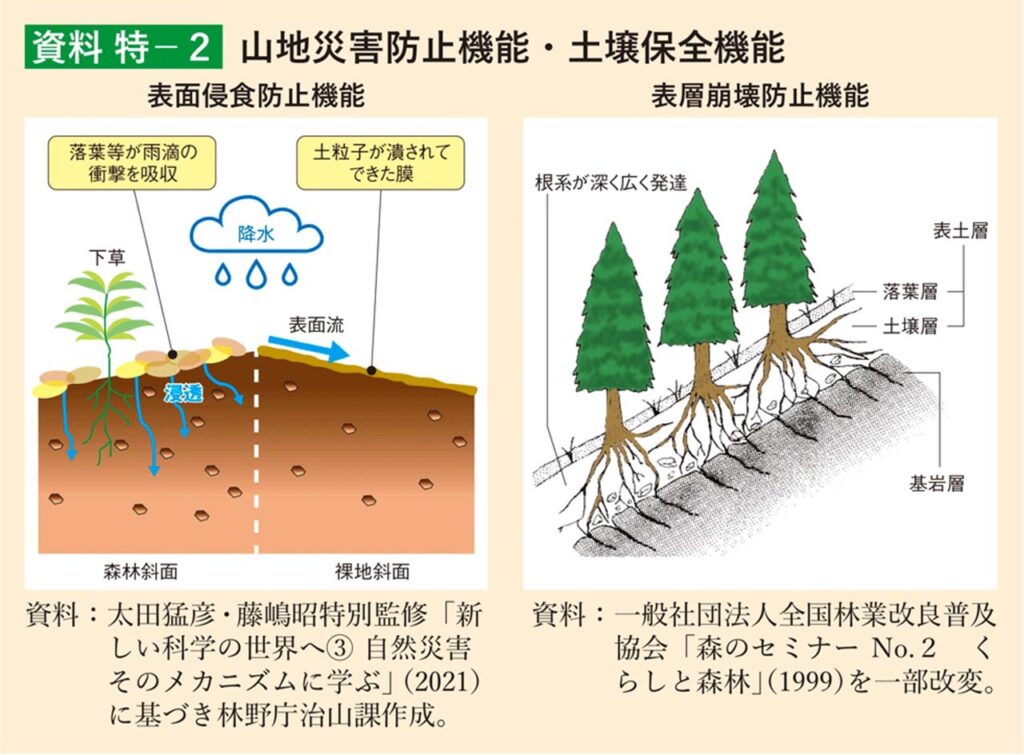Forests circulate with water, food, and the local community - Thinking about "SDGs x Forest Regeneration" from a lifestyle perspective
Updated by Sogo Kato on October 15, 2025, 8:52 PM JST
Sougo KATO
Leaf Rain Co.
After working for a financial institution researching companies in the high-tech field, he worked as a supervisor at a landscape construction site before setting up his own business. He is interested in the materials industry, renewable energy, and wood utilization, and in recent years he has been writing about the forestry industry. With his experience of working in the forests in the past, he aims to write articles that explore the connection between the realities of the field and the industrial structure.
Memories of roasting homemade Tochimochi (rice cake) with sweet bean paste on the stove at a relative's house in the mountains of Shinshu, eating thin-skinned chestnuts deep-fried and sprinkled with a little salt, mixing homemade konnyaku and ground walnuts with green tea and watching them turn a delicious milky white color --simple, but combined with the mountain air, it was surprisingly delicious. Behind the flavor, I felt the nutrition and richness nurtured by the mountains. Nuts such as horse chestnuts, chestnuts, and walnuts have supported people's lives since the Jomon period. Even since then, they have kept people fed in times of famine and are still rooted in the memory of the community. The realization that a single tree supports the cycle of life is the starting point for the SDGs and ESGs to reconsider the relationship between people and nature.
In recent years, not only Toyota and Suntory, but also other industries such as finance and IT have begun to participate in reforestation. 2022 will see the launch of the "Forest Growing Promotion Council," a public-private partnership, and a growing movement to rebuild the relationship between forests and people. However, companies and local governments are not facing forests simply out of the goodness of their hearts. It is because they need to re-communicate distant issues such as decarbonization and global warming into themes that are more familiar to our daily lives. Forest restoration is closely linked to everyday life, including disasters, water, food, and local economies.

Forests, known as "green dams," temporarily store rainfall and gently channel it into rivers. As a result, they reduce flood peaks and mitigate droughts. Disaster prevention is an investment that not only reduces livelihood risks but also supports financial sustainability.
Some estimates suggest that the economic benefits of forests (if all forests were replaced by construction work, etc.) would exceed 70 trillion yen per year due to flood and sediment disaster prevention effects.
On the other hand, the amount of annual flood damage in Japan has been on the rise in recent years. According to a survey by the Ministry of Land, Infrastructure, Transport and Tourism, the amount of annual flood damage in the 2000s was around 200-300 billion yen, but in the 2010s it reached around 500 billion yen, and in recent years, in particular, the amount has exceeded 500 billion yen. The increase in the 2010s is partly due to labor and material cost increases after the earthquake, but the main factor is the frequent occurrence of torrential rains due to climate change.
In Japan, countermeasures have so far focused on civil engineering projects such as levees and dams, but as we enter an era in which rainfall itself is exceeding expectations, concrete-based flood control alone can no longer keep up. The cost of restoration has ballooned with each flood and landslide disaster, straining local government finances.

Part of the reason behind the fluctuating prices of vegetables and rice is the decline of the mountains. Forests have nurtured groundwater by allowing rain to percolate into the ground, thus enriching farmland. However, in forests that have lost their care, water flows all at once, resulting in repeated floods and droughts. As a result, water for agriculture becomes unstable, and production and prices are shaken.
In the July 2020 Kumamoto torrential rains, the prefecture reported that of the approximately 522.2 billion yen in total damage, approximately 101.9 billion yen was caused by agriculture, forestry, and fisheries, which was as large as public works and buildings (housing). Such damage also spreads to urban areas through market prices. Water shortages and heavy rain damage caused by frequent abnormal weather threaten the stable supply of agricultural products. Restoring an environment where forests can gently circulate water and soil will help mitigate these effects and support food security. Reforestation is another way to improve the production infrastructure to sustain our livelihoods.
Reforestation with hardwoods will not only diversify the ecosystem, but also the industrial structure. Forest diversity is the key to restoring the sustainability of local economies. It is not that coniferous trees are bad. The problem is the vulnerability to market risk from a single business. The postwar expansion of afforestation was a rational decision to meet the demand for housing at the time, but the influx of foreign timber caused the industry to lose its price competitiveness and its profit structure collapsed. The essential problem facing the forestry industry lies in the single nature of the business. The one-time cash flow of logging and sales cannot absorb changes in the market environment. However, if a forest that is mainly coniferous trees is mixed with broadleaf trees and designed to have a variety of uses, a structure can be created to make the business profitable year after year. The quality of income will change and risks will be diversified, such as furniture, nuts and wild vegetables, tourism, and education.
By combining multiple sources of revenue rather than relying on a single market, forestry can be transformed into a more sustainable industry. Furthermore, as the 6th industrialization progresses, new jobs will be created in the manufacturing and processing stages, which will flow back into the local economy. The appeal of the forestry industry is shifting from "logging" to "designing forests and building a profitable structure. This is what reforestation means for regional development.
The word "reforestation" conjures up a somewhat distant image. Even though people are interested in the topic, they still do not seem to understand how it relates to their own lives on a daily basis. In reality, however, the health of forests affects water, food, employment, and even local economies. In other words, forests are not an "environmental issue" but an "infrastructure issue for living.
Corporate reforestation activities are no longer a part of image strategy or CSR, but are becoming a fundamental investment that supports the sustainability of society itself. With food shortages and the exhaustion of local economies looming ahead of us, reforestation is no longer just a "good deed. It is a necessary and realistic action to protect our way of life. (Sogo Kato, Forestry Writer, Leaf Rain Co.)